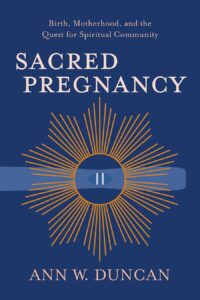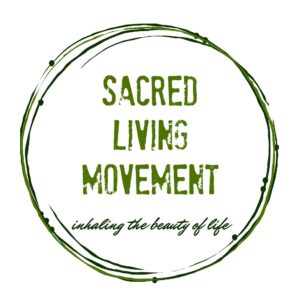Spiritual Reproductive Services
An excerpt from “Sacred Pregnancy: Birth, Motherhood, and the Quest for Spiritual Community”

(Image source: Getty Images. Image created by Tatyana Antusenok)
The following excerpt comes from Ann Duncan’s book Sacred Pregnancy: Birth, Motherhood, and the Quest for Spiritual Community from Fortress Press. The book explores the spiritual birthing movement in the United States.
This excerpt comes from the book’s Introduction and introduces readers to various components of the spiritual birthing movement.
***
 As one woman sings and plays guitar to set the mood, women enter a tent carefully decorated as the site of the sacred altar and creation of a sister circle. One by one, the pregnant women are blessed by their sisters through the laying on of hands, massage, and the feeding of fresh fruits. They then move to another tent where their bodies are transformed into those of mythical goddesses through adornment with paints, flowers, jewelry, and glitter before being photographed by the professional photographer on hand. Several times a year, pregnant women gather in locations throughout the world to engage in rituals such as these that affirm community, sisterhood, womanhood, and the sacredness of the rites of passage that are pregnancy and birth. More than just an isolated gathering of women interested in cultivating their spirituality, these rituals are part of a much larger movement that their creator, Anni Daulter, describes as potentially transformative not only for the women involved but for the world.
As one woman sings and plays guitar to set the mood, women enter a tent carefully decorated as the site of the sacred altar and creation of a sister circle. One by one, the pregnant women are blessed by their sisters through the laying on of hands, massage, and the feeding of fresh fruits. They then move to another tent where their bodies are transformed into those of mythical goddesses through adornment with paints, flowers, jewelry, and glitter before being photographed by the professional photographer on hand. Several times a year, pregnant women gather in locations throughout the world to engage in rituals such as these that affirm community, sisterhood, womanhood, and the sacredness of the rites of passage that are pregnancy and birth. More than just an isolated gathering of women interested in cultivating their spirituality, these rituals are part of a much larger movement that their creator, Anni Daulter, describes as potentially transformative not only for the women involved but for the world.
Though the rituals of the Sacred Living Movement may conjure associations with ancient rituals in tribal societies, they are, in fact, contemporary examples of a new form of religious and spiritual community in the United States. The rituals come from one of the many Sacred Pregnancy retreats offered by the Sacred Living Movement, a business and spiritual community providing online and live support, gatherings, and trainings seeking to bring community, ritual, and the sacred back to, among other things, the rites of passage that are pregnancy and birth.
***
In a small office in a suburb of Washington, D.C., a woman sits atop a wooden box fitted with a hole at the top and steaming apparatus inside. The woman sits, bare bottomed, above the hole, and receives a “womb steam” as a means of physical and spiritual renewal. During the steaming – a procedure designed to heal, cleanse, and rebalance the internal and external parts of a woman’s reproductive organs – the woman receives spiritual counseling from the Reverend High Priestess Thema Azize Serwa, a certified doula, reiki, aromatherapy, and herbalism practitioner. A short drive away, Munera Fontaine offers Mother’s Blessings to facilitate a communal ritual to honor and bless an expectant mother and to prepare her for the rite of passage that is childbirth.
***
In online trainings and in-person workshops, Amy Wright Glenn—author, birth and death doula, hospital chaplain, and expert in the art of holding space—trains birth workers, doulas, chaplains, and others with an interest in how to create space, foster reflection, and guide others through life’s most dramatic transitions. Raised in the Church of Jesus Christ of Latter-Day Saints, Glenn uses her own academic training in world religions to facilitate rites of passage and support during times of joy and loss in ways that integrate and respect the religious and spiritual worldview of the practitioner. With a particular interest in pregnancy and child loss, Glenn blends business with spirituality, an agnostic sensibility with an adaptability to a wide spectrum of religious and spiritual practice, as she trains and guides others in skills and services aimed at supporting individuals through the joys and sorrows of pregnancy, birth, and death.
***
Though geographically dispersed from Oregon to Florida to Washington, DC, and serving a broad spectrum of clientele, the work of Anni Daulter, Thema Azize Serwa, Munerra Fontaine and Amy Wright Glenn are but four examples of the growing number of movements that blend business with a spiritual approach to the reproductive health and rites of passage of women. The rituals, interpersonal connections, and communities emerging from these spiritual communities and practitioners provide these individuals with experiences that they are unable to find elsewhere and that are missing from modern society. Where once pregnancy and childbirth were the shared experience that bonded the pregnant and birthing people in a community together through the trials of the physical and temporal embodiment of these life stages, the enactment of physical and emotional support, and accompanying ritual and pregnancy, and the resulting childbirth have become individualistic, medicalized experiences and procedures. Whereas women once labored and birthed at home, surrounded by women from their families and communities, they now often birth in sterile hospital environments surrounded by doctors, nurses, and their partners. Whereas women once received care that was holistic, women’s reproductive health has been clinicalized and even ignored by medical establishment. Rather than moving through the birth process following the callings of one’s own body or guidance derived from the lived experience of older women, birthing women are directed to lie or stand, push, or refrain from pushing based on medical standards, a desire for expediency, and convenience for hospital staff and administrators.
Advocates of these new directions in spiritual reproductive services and communities for women argue that this cultural shift has effectively converted what was a natural, community-supported rite of passage to a sterilized and individual medical procedure. Postpartum mothers are given little attention regarding their own physical recovery and spiritual transformation as focus shifts to care for the newborn baby. Proponents of these services and movements toward more natural, person-centered pregnancy and birth experience argue that in addition to recent increases in maternal fatality rates, birthing individual’s experiences have been negatively affected, not just emotionally but also physically. For these practitioners, the rites of passage and experiences surrounding motherhood have the potential to be vehicles for religious or spiritual experience and the formation of community.
Contested Maternal Paradigms
In practice and in scholarship, refocusing attention on this facet of many women’s lives opens the door to an experience and set of experiences that have the potential to restrict, yes, but also to empower and to deepen the spectrum of emotions a woman experiences in her time on earth. As Anni Daulter, founder of the Sacred Living Movement, describes, “in the moment of birthing a baby, she is the most powerful woman in the world.” For those who experience childbirth as a rite of passage and opportunity for empowerment, it has evolved into what Robbie Davis-Floyd calls a “secret sisterhood.” Because birth is experienced by many as a fundamentally life-changing event but is not discussed as such, a void remains for women seeking connection with their sisters in this rite. This is but one manifestation of the systematic silence surrounding the experience of mothering that Susan Maushart terms the “mask of motherhood.” Daulter sees the Sacred Living Movement as a way to ensure that “no pregnant woman … feel[s] alone during such a life-altering experience.” For Muneera Fontaine, owner of Peaceful Earth Graceful Birth, a Washington, DC-based company focused on birth and postpartum support and womb healing, it is also an issue of basic rights: “Healthcare is a human right that should not be held in monopoly by those who can afford it.” Her commitment is to provide not only more meaningful and effective services but more accessible services as well.
 In many ways, this rethinking of pregnancy, birth, and fetal or infant death as sites for sacred or religious ritual follows patterns in liberal Protestantism throughout American history. The use of ritual follows patterns that Pamela Klassen maps through the history of liberal Protestantism in North America. The ritual is a means by which these practitioners “evoke and articulate their religious blending.” Moreover, the use of ritual as an integral part of pregnancy and childbirth suggests a desire for practice that encourages the connections one desires with the transcendent.
In many ways, this rethinking of pregnancy, birth, and fetal or infant death as sites for sacred or religious ritual follows patterns in liberal Protestantism throughout American history. The use of ritual follows patterns that Pamela Klassen maps through the history of liberal Protestantism in North America. The ritual is a means by which these practitioners “evoke and articulate their religious blending.” Moreover, the use of ritual as an integral part of pregnancy and childbirth suggests a desire for practice that encourages the connections one desires with the transcendent.
This ritualization occurs outside the bounds of institutional religion as well. In her discussion of the commonalities between spirituality and religion in the context of the increasingly popular label “spiritual but not religious,” Linda Mercadante notes not only a belief in something greater and a desire for connection to it but also “the proportion of rituals and practices as an aid or witness to this connection.” This desire for ritual and connection, Mercadante argues, undermines another common misperception of the spiritual but not religious: that they desire individual practice apart from community. Instead, they desire community as a context in which to enact ritual.
Motherhood, Feminism, and the Sacred
It is to these new forms of spiritual community focused on pregnancy and birth that this book turns. Part a retrospective on evolving paradigms of and feminist discourse on motherhood, part sociological study of changing religious demographics and understandings of religious experience in the United States, and part ethnographic study of the Sacred Living Movement and other spiritual movements and spiritually guided reproductive health services, this book uses case studies to demonstrate the ways in which these rites of passage are powerful sites of spiritual and religious practice. That practice necessarily unsettles not only many maternal paradigms but also those of religion and spirituality in ways that attract many of the so-called religious nones and others unhappy with the strictures of traditional religion. The case studies are also an invitation to theorize further and investigate not only the social construction of motherhood but maternity itself as a window into the life experience of many women and a potential avenue to religious and spiritual practice.
Ann W. Duncan is a professor of American studies and religion at Goucher College in Baltimore, Maryland.
***
Interested in more on this topic? Check out episode 39 of the Revealer podcast: “The Spiritual Birthing Movement.”